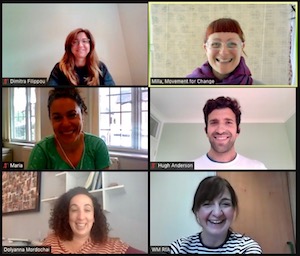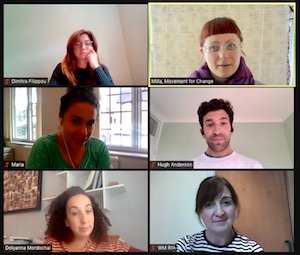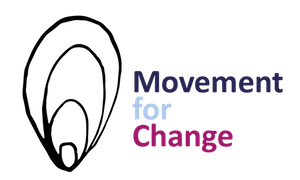Resources for Autism (RfA) is a national charity supporting people with autism and their families. With 250 staff and 60 volunteers, RfA provides services in London, Birmingham and online.I worked with RFA to review organisational wellbeing (levels, drains and supports) and to put together a three-year wellbeing strategy.
This is now in place and a valued part of the organisations work, as a colleague described –
“It shows a level of investment and care in this aspect of our practice. It also paves the way for smaller developments and changes in the future to come from a robust starting point.”
How it all started
The organisation had started to consider wellbeing strategically when the pandemic hit. RfA quickly put a range of offerings (many voluntary) in place during then in late 2020, having seen the positive impact of these measures on staff, RFA decided to put a strategy in place to secure these benefits for the longer term, and enlisted support from Movement for Change.
They also fundraised successfully from an existing funder as part of their Covid response offer.
The Wellbeing Group
We started by establishing a staff wellbeing group with representation across the organisation. Since then the group has:
-
Shared initial thoughts and feelings about wellbeing risks and challenges
-
Decided on an overall approach to wellbeing (the What Works Wellbeing Five Pillars + associated question bank)
-
Improved the range, quality and amount of workforce wellbeing offers
-
Held a full consultation with staff (survey + interviews) on wellbeing levels, drains and supports
-
Developed a three-year wellbeing strategy

The group’s first few meetings were a whirlwind of sharing ideas for immediate improvements, as well as views and concerns about wellbeing at RfA. We brainstormed different approaches and reported back on seminars and conferences run by consultancies and bodies such as the CIPD, as we all immersed ourselves in the world of workplace wellbeing. It became clear that we’d need to settle on an initial approach to tie all the ideas together and make them approachable – ‘wellbeing’ is just too big! We also reflected on the need to mesh any wellbeing developments with existing HR and workforce policy and practice, to avoid it sitting separately to RfA’s day to day activity and processes.
Picking a wellbeing approach
Movement for Change reviewed 14 potential models; the group narrowed them down to two (CIPD and WWW). After much soul-searching, we selected WWW given its wide applicability, question bank and research resources, and a case study presentation which brought the approach to life.

Learning about wellbeing in the organisation
The next step was to design a consultation process and select questions for a staff survey. We combined 17 quantitative questions from the WWW Question Bank to assess wellbeing levels with more open qualitative questions exploring colleagues’ wellbeing drains and supports. It was a real challenge to narrow things down, and on reflection we probably included too many – although now we have the data it’s also possible to assess what to leave out, next time in an informed way.
With the survey and interviews, we found out a lot of useful information; some confirming gut feelings of the group, some bringing new perspectives. (Wellbeing Group member)
Some question examples (using five-point agree/ disagree answer scales) included:
-
I have a manageable workload
-
I would be confident talking to my line manager about a mental health problem (which might include anxiety, stress or depression)
-
I generally get on well with my work colleagues
-
I would recommend my organisation as a great place to work
Open questions included:
-
What have been the main challenges to your wellbeing at RFA over the past year?
-
What has supported your wellbeing at RFA over the past year or so? This could be within work, or outside the work environment
-
RFA is now developing a wellbeing strategy and is setting priorities for the years ahead. What do you feel the top 3 priorities should be for this strategy?
We piloted the survey with four people from different roles and parts of the organisation, then shared it for three weeks. 57 people (29% of staff) answered, and the results were summarised and shared initially with the wellbeing group, then with managers, and finally with all staff via the team structure. Now, insights from the consultation process have been integrated into the draft strategy.
The strategy itself
The strategy sets out RfA’s vision and plan to raise workforce wellbeing over the next three years, so that everyone in the workforce is supported and looked after, and people know where to go for support when specific challenges arise. In developing it, one of our frustrations was finding few useful or relevant examples of a wellbeing strategy structure.
In the spirit of sharing, here’s what we came up with:
-
About this strategy
-
Background, including the organisation’s overall vision, mission and values
-
Why is workforce wellbeing important?
-
The Wellbeing Group and its work
-
Wellbeing approach selected
-
Fit with other policies
-
-
Current practice
-
Consultation findings
-
Drains on wellbeing
-
Supports for wellbeing
-
-
Addressing wellbeing drains, building on existing supports
-
Taking a systems approach
-
Y1 action plan
-
Responsibility for leadership and delivery
-
Risks and mitigations
-
-
Monitoring progress
The strategy has now been signed off and the organisation will continue to seek additional funding for on-going workforce wellbeing work. As it beds in, colleagues are already seeing some changes:
I’ve noticed other staff (at different levels in the organisation) are talking more openly about well being and I’ve seen the courage of some staff who have come forward and said they’re not okay and need some support. (Wellbeing Group member)
Top tips from our group for you as you get started on your wellbeing strategy include:
-
Go for it! Remember change takes time and it needs an investment and interest across the organisation for effective shifts to happen.
-
Consider how this can happen in a realistic and sustainable way.
-
Be patient! Wellbeing is a huge topic, so much reading and different frameworks it’s never ending; but so worthwhile to try and change the narrative and making the commitment to improve workplace wellbeing – why would you not want to do this?



